LED Outdoor Lamps: Types, Benefits, and Installation Tips
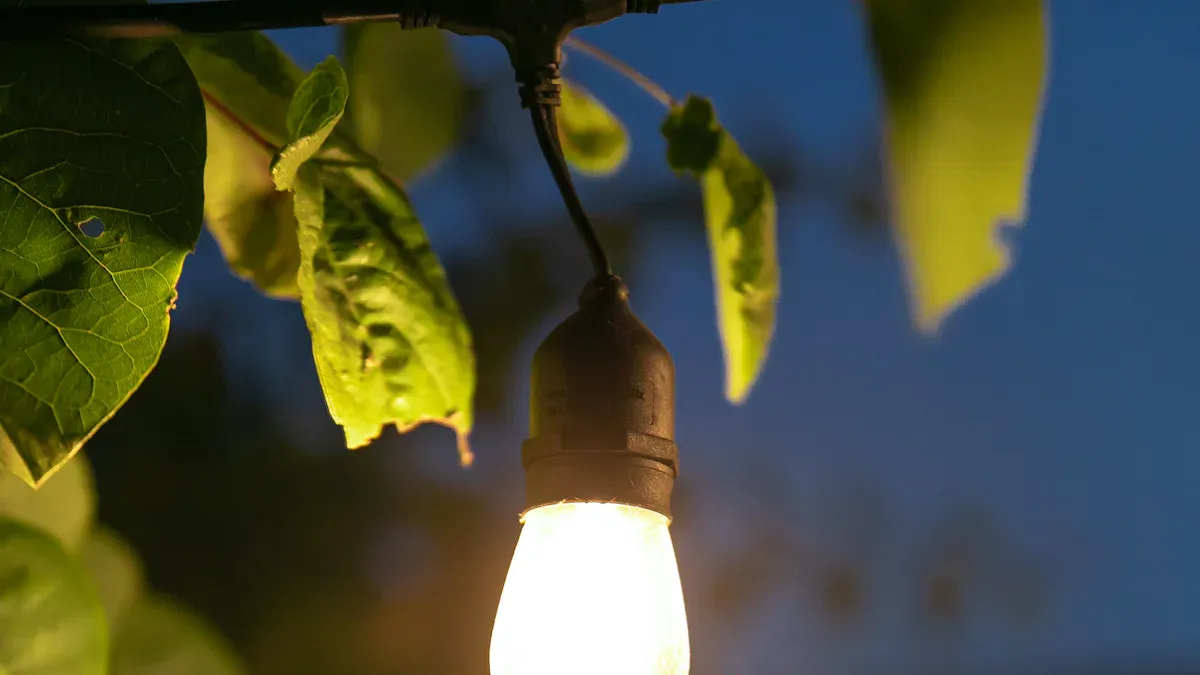
You use LED outdoor lamps to brighten up the outside areas of your home. These LED lights are powerful and energy-efficient, making them a popular choice. In fact, LED outdoor lighting now accounts for nearly half of all outdoor lighting in both homes and businesses. Here’s a quick comparison:
Lighting Technology | Residential (%) | Commercial (%) | Overall (%) |
|---|---|---|---|
LED | ~48 | ~47 | ~47.5 |
Incandescent + Halogen | ~19.2 | ~1.1 | ~15.5 |
Compact Fluorescent (CFL) | ~25 | ~3.3 | ~20.3 |
Linear Fluorescent | ~8 | ~48 | ~16.2 |
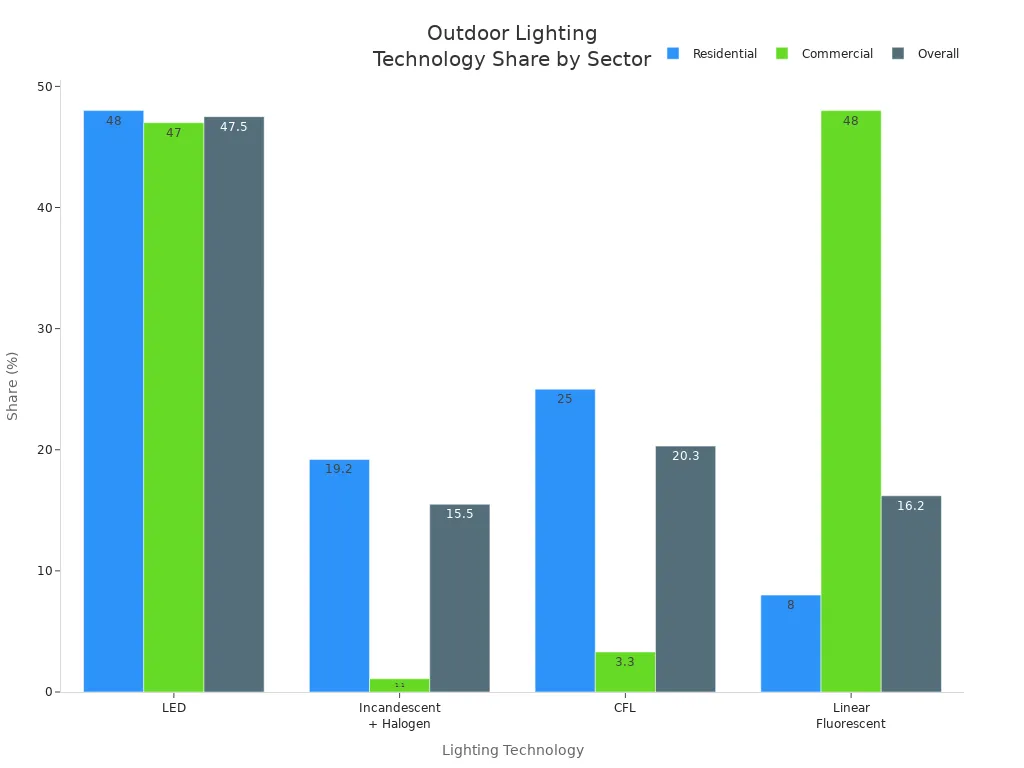
Most people choose LED outdoor lamps for several reasons:
They use less energy, helping you save money at home.
LED outdoor lights have a long lifespan and require minimal maintenance.
These LED lights perform well in any weather and come in a variety of styles.
LED outdoor lamps stay cool to the touch, making them safer for families.
For the best results, proper installation is key to maximizing the performance of your LED outdoor lamps. You can use these LED outdoor lights as floodlights, wall packs, post lights, deck lights, or for landscape lighting. To learn more about our product offerings and company background, visit our About Us page. LED outdoor lamps enhance your outdoor lighting by providing efficiency, durability, and style for your home.
Key Takeaways
LED outdoor lamps use less power than old lights. They help save energy and money. They also last much longer than regular lights.
There are different types of LED outdoor lights. Each type has its own job. Floodlights light up big spaces. Wall packs are for walls. Post lights help light up paths. Deck lights keep people safe. Landscape lighting makes places look nice and safe.
Good planning helps your outdoor lights work better. It also keeps things safe. Always turn off the power before you start working. If you are not sure, ask a professional for help.
LED outdoor lamps work in any weather. They do not need much care. You can pick from many colors and brightness levels. This helps set the mood and keeps things safe.
Smart LED outdoor lights make things easier. They help save more energy. They have remote control, motion sensors, and timers.
Types of Outdoor LED Lighting
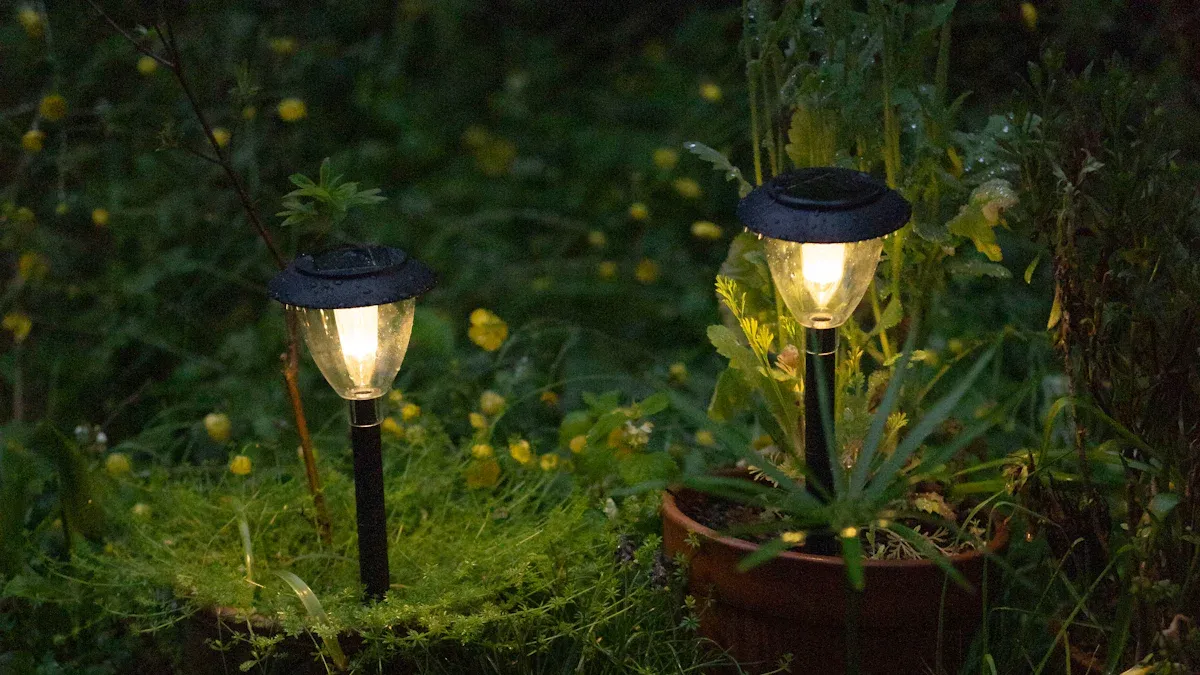
Outdoor LED lighting comes in many shapes. Each type has a special job. You can pick from different kinds to fit your needs. Some help with safety. Others add style or save energy. Here are the most common types and how you use them.
Floodlights
Floodlights shine bright, wide beams of light. You use them to light big spaces like driveways or yards. They help you see at night and keep away strangers. LED floodlights use less energy and last longer than old ones. They start at 800 lumens and go over 3000 lumens for large areas. You can choose warm or cool colors to set the mood.
Tip: LED floodlights use smart optics. They send light where you want it. This means less wasted light and better coverage.
Here is a quick look at LED floodlights and halogen floodlights:
Feature | LED Floodlights | Traditional Halogen Floodlights |
|---|---|---|
Brightness (Lumens) | 800+ (can exceed 3000) | Similar, but needs more power |
Power Consumption (Watts) | 30-100 | 300-1000 |
Luminous Efficacy | 15-25 lumens per watt | |
Light Distribution | Directional, controlled beam | Omnidirectional, needs reflectors |
Coverage Control | Precise, less wasted light | Less control, more light spillage |
Energy Efficiency | High | Low |
You can use floodlights at home or at work. They work well with motion sensors for extra safety.
Wall Packs
Wall packs are lights you put on walls. You see them on buildings, garages, or walkways. They give wide, even light to help you see at night. In businesses, wall packs light up outside walls and parking lots. At home, use them for yards or entryways.
Wall packs come in many styles like lanterns or sconces.
Their strong design makes them good for homes and businesses.
Note: Wall packs are great when post lights do not work.
Post Lights
Post lights are tall lights for paths or driveways. These LED lights help you see where you walk. They also make your yard look nice. You can find post lights in many designs, from old to new.
Post lights make walking safer by lighting dark spots.
They add charm and show off your yard.
Many post lights have smart features like motion sensors.
Use post lights to welcome guests and show off your garden.
Deck Lights
Deck lights are small LED lights for decks. You put them on stairs, railings, or floors. These lights help you walk safely at night. They also make your outdoor space feel cozy.
Deck Stairs: Put LED lights on stairs to stop trips. This also shows off your deck.
Undercap Lighting: Put lights under railings for a soft glow.
Recessed Deck Lighting: Put lights in the floor for a modern look.
Hanging Deck Lights: Use string lights or lanterns for fun seating areas.
Tip: Always use weatherproof connections for deck lights. This keeps them safe and working longer.
Landscape Lighting
Landscape lighting uses LED lights for gardens, trees, and paths. You use this lighting to make your yard safer and prettier. Good landscape lighting keeps away strangers and helps you avoid falls.
LED landscape lighting lets you enjoy your yard at night. You can show off trees or flower beds. It helps you spend more time outside with friends or family. LED landscape lighting saves energy and lasts a long time. It is a smart choice for any yard.
Did you know? LED landscape lighting can make your home worth more. It makes your house look nicer and more welcoming.
Types of Outdoor LED Lighting: Distribution Patterns
You can pick outdoor LED lighting by how the light spreads. Here is a table showing common patterns and where to use them:
Distribution Type | Design Pattern Description | Typical Applications |
|---|---|---|
Type II | Slightly wider linear beam | Narrow roads, alleys, side streets |
Type III | Wide, forward arc | Parking lots, roadways, drive lanes |
Type IV | Narrow, forward throw | Perimeters, building facades, wall mounts |
Type V | Symmetrical circular or square | Large lots, plazas, intersections |
Each LED outdoor light has a special use. Floodlights and wall packs help with safety. Post lights and deck lights add style and guide you. Landscape lighting makes your yard look great and keeps it safe. Pick the right light to make your space beautiful and secure.
Benefits
Energy Efficiency
Switching to LED outdoor lighting saves a lot of energy. LED outdoor lamps use only 8-20 watts. Halogen lamps need much more power, about 29-72 watts. LEDs turn most of their energy into light, not heat. Incandescent bulbs waste energy as heat. If you use an LED instead of a 60-watt incandescent bulb, you can use up to 73% less energy. Most people save about 70-80% on energy. This means you pay less for electricity and help the earth. Many people and businesses see lower bills because LEDs use less power. LEDs also work well with smart controls.
Durability & Weather Resistance
LED outdoor lighting can handle tough weather. You do not need to worry about rain, snow, or heat. These lights are built strong and do not break easily. They keep working in harsh weather. Many LED fixtures use tough materials like aluminum and polycarbonate. They have seals that keep out water. You can trust them to last through storms or falling branches.
Solid-state design helps stop shattering.
Sealed housings keep water and dust out.
Strong materials handle bumps and hot or cold weather.
Long Lifespan
LED outdoor lamps last much longer than other bulbs. Most LEDs work for 25,000 to 50,000 hours. Some good ones last up to 100,000 hours. Incandescent bulbs only last about 1,000 hours. CFLs last up to 15,000 hours. Because LEDs last so long, you do not need to change bulbs often. This saves you time and money.
Lighting Technology | Typical Lifespan (hours) | Relative Lifespan Compared to LED |
|---|---|---|
LED Outdoor Lamps | 25,000 - 50,000 (up to 100,000) | Baseline (1x) |
Incandescent Bulbs | ~500 - 1,000 | ~1/50th of LED lifespan |
Halogen Bulbs | ~2,000 - 2,500 | ~1/20 to 1/25 of LED lifespan |
Compact Fluorescent Lamps (CFLs) | 8,000 - 15,000 | ~1/3 to 1/6 of LED lifespan |
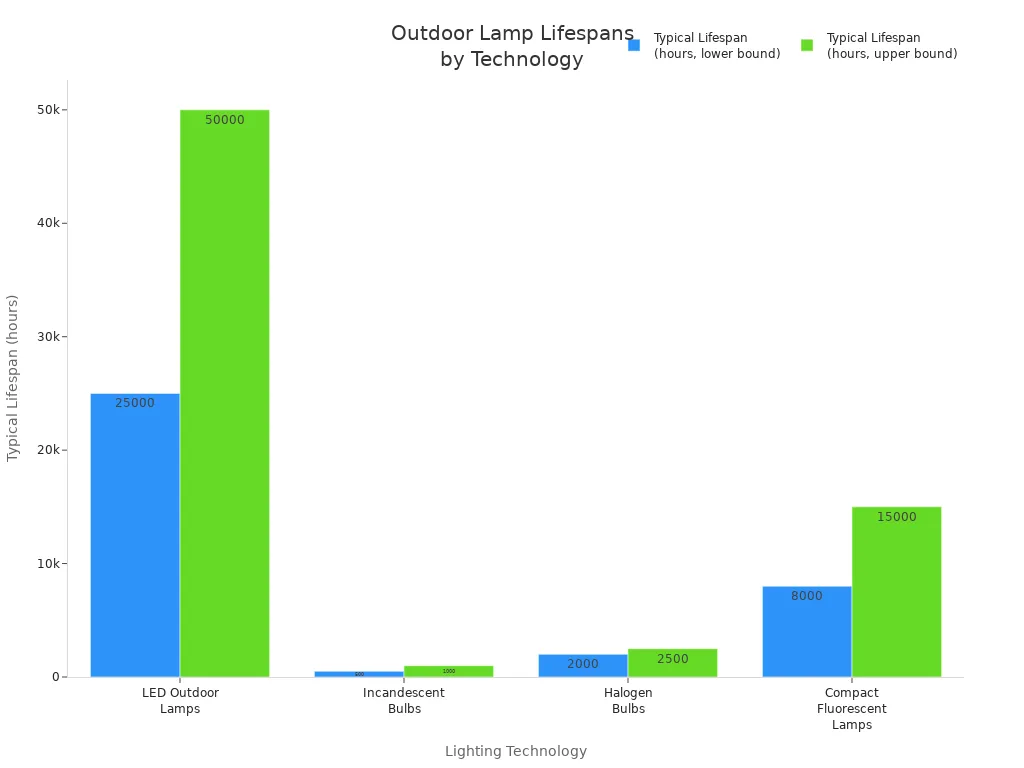
Low Maintenance
LED outdoor lighting needs little care. LEDs almost never fail and work in all weather. You do not have to change bulbs often. This is helpful for hard-to-reach places. Fewer changes mean less work and lower costs.
Light Quality & Color Temperature
LED outdoor lighting gives you lots of choices for color and brightness. You can pick warm white (2700K-3000K) for a cozy look. Cool white (4000K-6000K) is bright and clear. Warm colors are good for patios and gardens. Cool colors work best for security and driveways. You can set the mood and make your space safer.
Color Temperature (Kelvin) | Recommended Outdoor Fixtures | Effect on Outdoor Ambiance and Functionality |
|---|---|---|
2700K - 3000K (Warm White) | Outdoor wall lights, post lights, path lights, accent lights, solar lights, outdoor lamps, ceiling lights, barn lights, bollard lights | Cozy, inviting, relaxing; enhances curb appeal and ambiance; good for accent and pathway lighting |
4000K - 6000K (Cool White) | Flood lights, security lights, motion sensor lights | Bright, clear; improves visibility and safety; ideal for security and functional lighting needs |
Environmental Impact
LED outdoor lighting is good for the environment in many ways:
Uses about 75% less electricity than incandescent bulbs.
Lasts up to 25 times longer, so you throw away fewer bulbs.
Has no toxic chemicals like mercury.
100% recyclable, which means less waste.
Cuts greenhouse gas emissions by using less energy.
Works well with solar power for even greener lighting.
Note: Some LED outdoor lamps may not be as bright as some old lights, but the many benefits of led outdoor lighting make them a smart choice for most outdoor spaces.
LED Outdoor Lamps Installation
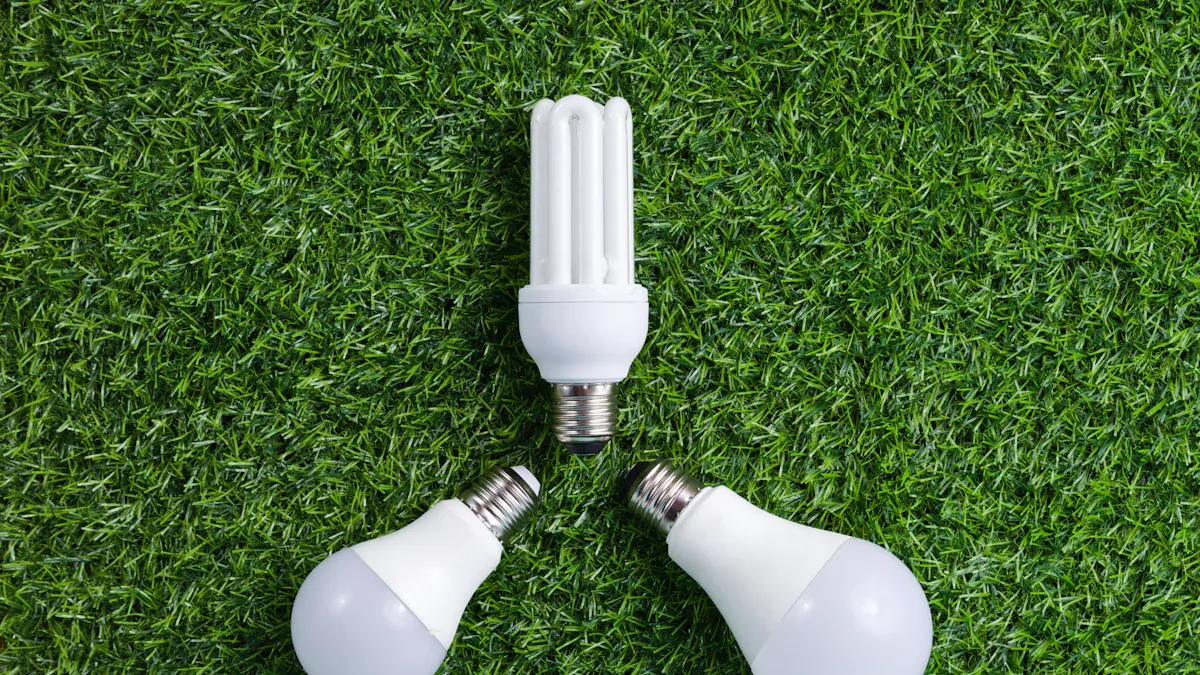
Planning
Good planning helps you get the best results from your outdoor lighting. Start by looking at your yard or outdoor space. Walk around and decide what you want to light up. You might want to highlight a tree, make a path safer, or add a motion-sensor light for safety and security. Set clear goals for your lighting project.
Follow these steps to plan your installation:
Map Your Space: Draw a simple map of your yard. Mark important features like walkways, patios, and doors.
Set Your Goals: Decide if you want to improve safety, add beauty, or both. Think about where you need more light.
Pick the Right Fixtures: Choose weather-resistant fixtures that match your style. Make sure they are the right size for your space.
Plan Placement: Use path lights for walkways, wall lights for doors, and spotlights for trees or signs. Place lights to avoid dark spots.
Check Power Needs: Make sure you have enough power for all your lights. Use the right transformers and wiring.
Think About Safety: Light up stairs, slopes, and other hazards. Use motion-sensor lights near entries for extra protection.
Design for Looks: Use warm colors for a cozy feel. Shield lights to avoid glare and reduce light pollution.
Plan for the Future: Choose durable fixtures with warranties. Think about adding smart controls later.
Tip: Careful planning saves time and money. It also helps you avoid mistakes during installation.
Choosing the Right Lamp
You need to pick the best LED lamp for each spot in your yard. Think about what you want the light to do. Some lights help you see better at night. Others make your home look nice. Here are some things to consider:
What is the main purpose? Safety, looks, or both?
When will you use the lights? For evening parties, pick warmer lights.
How big is your space? Large areas may need more than one fixture.
How bright should it be? Use 200-400 lumens for paths. Use 800 lumens or more for security.
What color do you want? Warm white (2700K-3000K) feels cozy. Cool white (4000K-5000K) looks modern.
Is the fixture energy efficient? Look for Energy Star labels.
Will the fixture last outside? Pick lights with high IP ratings and strong materials.
Do you want smart or solar-powered options? These can save energy and add convenience.
Does the style match your home? Pick fixtures that fit your house and yard.
Note: Always check if the lamp is made for outdoor lighting. This helps it last longer and work better.
Safety Tips
Safety matters when you install LED outdoor lamps. You want your lights to work well and keep your family safe. Here are some important tips:
Never add new lights to old poles without checking if they can handle the weight and power.
Make sure all wiring and connections are tight and safe. Loose wires can cause shocks or fires.
Plan your lighting design before you start. This helps you avoid mistakes.
Use only high-quality LED lights and fixtures. Cheap products may fail or cause problems.
Hire a professional if you are not sure about electrical work.
Use GFCI outlets for all outdoor lighting. These outlets protect you from shocks.
Check your lights often. Clean them and look for damage.
Alert: Always turn off the power at the breaker before you start any installation.
Step-by-Step Guide
You can install LED outdoor lamps yourself if you follow the right steps. Here is a simple guide:
Turn Off Power: Go to your breaker box and switch off the power for outdoor lighting. Use a voltage tester to make sure the power is off.
Gather Tools and Materials: Get all the tools you need, like a drill, wire strippers, screws, and your new LED fixtures.
Understand Your Electrical System: Find out which circuits control your outdoor areas. Ask a professional if you are unsure.
Prepare the Wires: Strip about half an inch of insulation from the ends of the wires.
Connect the Wires: Match the colors—black to black, white to white, and green or bare to ground. Twist the wires together and cover them with wire nuts. Wrap with electrical tape.
Mount the Fixture: Attach the mounting bracket to the wall or post. Use the right screws and make sure it is tight.
Install the Lamp: Place the LED fixture on the bracket. Tighten all screws so it does not move.
Seal for Weather: Check all seals. Use silicone caulk if needed to keep water out.
Arrange the Wires: Run the wires neatly along the structure. Use clips to keep them in place.
Check Connections: Double-check all wiring with a voltage tester.
Restore Power and Test: Turn the power back on. Test each light to make sure it works.
Adjust Angles: Aim the lights to highlight features and avoid glare.
Follow Instructions: Always read and follow the manufacturer’s instructions for your fixture.
Tip: Use insulated tools and keep your ladder steady. Always keep three points of contact when climbing.
Troubleshooting
Sometimes, problems happen after installation. Here are common issues and how you can fix them:
Problem | Common Causes | How to Fix |
|---|---|---|
Loose wiring, bad drivers, voltage changes | Tighten wires, use LED drivers, check voltage | |
Dim Lights | Weak power, old LEDs, overheating | Check voltage, replace old LEDs, improve airflow |
Light Not Turning On | Blown fuse, bad wiring, dead LEDs | Replace fuse, fix wiring, change LEDs or fixture |
Buzzing Noise | Wrong dimmer, driver issues | Use LED dimmers, replace driver |
Discoloration | Overheating, poor-quality LEDs | Improve airflow, use better LEDs |
Water Damage | Leaks, poor seals | Use waterproof fixtures, seal gaps |
Short Lifespan | Too much heat, bad parts, power surges | Add ventilation, use quality parts, install surge protectors |
Remote Not Working | Dead batteries, interference, bad receiver | Change batteries, remove blocks, reset receiver |
Note: If you use a motion-sensor light and it does not work, check the sensor’s angle and clean the lens. Make sure nothing blocks the sensor.
You can solve most problems with simple checks. If you cannot fix the issue, call a professional for help. Regular checks and cleaning help your outdoor lighting last longer and work better.
Outdoor Lighting Tips
Placement
Think about where you put each lamp outside. This helps your lighting work well and look nice. Put wall sconces or outdoor wall lights near doors. This gives bright light for safety. Use pathway lights, string lights, and color-changing fixtures on patios and decks. These make the space warm and fun for parties.
Put spotlights and floodlights in gardens and lawns. They show off plants and cool things. Solar-powered lights save energy.
Use different kinds of lighting together. Mix ambient, task, and accent lights for more interest.
Place path lights close to the ground. This stops glare. Space them 6-8 feet apart for even light.
Mount wall lights at eye level. This makes light even and shows off doors or columns.
Use motion-sensor led lights in dark corners, on stairs, and in parking lots. This keeps people safe and stops accidents.
Tip: Change the brightness and color of your led lamps. Match them to what you are doing or how you feel. This helps you set the mood for any event.
Style & Function
Pick led outdoor lamps that match your home’s style. Some popular styles are floodlights, string lights, deck and step lights, pendant lights, wall sconces, and wall lanterns. Floodlights are good for big gardens and driveways. String lights make seating areas feel cozy and magical. Deck and step lights help people see stairs and decks at night.
Choose fixtures that look good with your house. Modern homes look nice with simple designs. Rustic homes look better with wood or copper. Dark-sky fixtures cut down on light pollution and save energy. For homes, use pathway lights with warm colors. This makes walkways safe and friendly. Accent lighting like spotlights can show off trees or cool things in your yard.
Note: Mixing ambient, task, and accent lighting makes your outdoor space lively. This mix helps with safety and style.
Smart Features
Smart led outdoor lamps let you control your lights easily. You can change colors, brightness, and scenes for any event. Use your phone or voice to turn lights on or off. Set timers so lights follow sunrise and sunset. Motion sensors turn lights on only when needed.
Smart Feature | Benefit |
|---|---|
Control lights from anywhere | |
Automation & Scheduling | Lights turn on or off at set times |
Motion Sensors | Lights come on when someone moves |
Dimming | Lower brightness to save energy |
Integration | Connect with security systems for safety |
Smart features help you save money and make your lights easy to use. Dark-sky smart fixtures also protect the night sky by cutting down on glare and extra light.
You can pick from many led outdoor lights for your house or business. Flood lights and wall packs are good choices. These led outdoor lamps save energy and last a long time. They also work well in bad weather. The table below shows the main benefits:
Benefit | Description |
|---|---|
Energy Efficiency | Lower electricity bills and less waste |
Durability | Withstands harsh outdoor conditions |
Enhanced Safety | Improves visibility and security |
Environmental Impact | No toxic materials, reduces carbon emissions |
If you plan and place your lights carefully, they work better. Think about what you need before you buy led outdoor lights. Pick the best fixtures for your space. Led outdoor lamps help make your home or business safer and brighter.
FAQ
How long do LED outdoor lamps last?
You can expect most LED outdoor lamps to last between 25,000 and 50,000 hours. Some high-quality models work even longer. You will not need to replace them as often as traditional bulbs.
Can you use LED outdoor lamps in wet or snowy weather?
Yes, you can use LED outdoor lamps in rain or snow. Look for fixtures with a high IP rating. These lamps resist water and dust. Always check the product label for weatherproof features.
Do LED outdoor lamps attract bugs?
LED outdoor lamps attract fewer bugs than traditional lights. Choose lamps with warm color temperatures (below 3000K) for best results. Bugs see less of this light, so your outdoor space stays more comfortable.
Are LED outdoor lamps safe to install yourself?
You can install many LED outdoor lamps yourself if you follow safety steps. Always turn off the power before starting. If you feel unsure, hire a licensed electrician for help.
What is the best color temperature for outdoor lighting?
You should use warm white (2700K-3000K) for patios and gardens. This creates a cozy feel. Use cool white (4000K-6000K) for driveways and security. This gives you brighter, clearer light.
See Also
Exploring Outdoor LED Lighting: Benefits, Types, And Installation Advice
Best Practices For Installing LED Exterior Lights And Their Benefits
A Comparison Of Outdoor Lamp Models, Features, And Setup Tips
Guide To LED Replacement Lighting: Types, Advantages, And Installation
Indoor LED Lamps Explained: Types, Uses, And Residential Benefits

